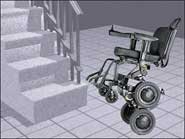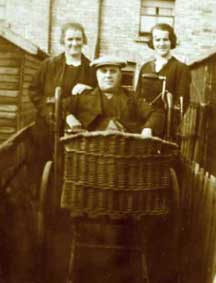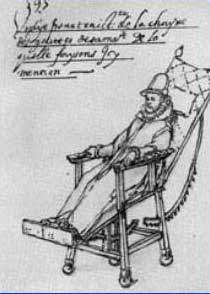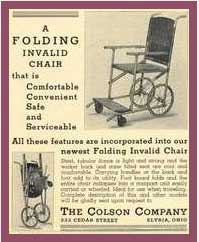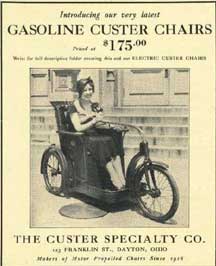|
|
|
|
Current State of Wheelchair Technology
|
|
|
|
|
|
|
|
|
|
|
|
History:
The wheelchair has been around for only about four centuries. Before that people who were crippled used only crutches or some other type of cane. In Egypt people were carried on carts. During the twelfth century the wheelbarrow was introduced to Europe. Wheelbarrows came from China and were first used in gardening, but led to many other inventions like the Chinese rickshaw. Wheelbarrows were very useful for crippled people, but it meant they had to get someone to push them. In 1588 Balthazar Hacker from Nuremburg, Germany invented a chair on wheels that could be moved and also turn into a bed. There are no pictures of that chair, but there are drawings of Philip II seated in a quilted back chair with hinged arms and ratchets for adjustments. It was designed for the King of Spain by Jehan Lhermite, a Flemish nobleman.
In 1644 a paraphelgic watchmaker made himself a chair using metal cogwheels that you turned on cranks. This allowed him to move by himself, a big step in wheelchair technology. The next big move forward was in the mid-18th century when John Joseph Merlin designed a wheelchair with the large full size wheels with an smaller outer wheel used to turn the wheels. This meant that the rider could easily move the wheels without getting his hands dirty. Since that time the wheelchair has not changed fundamentally. Merlin also invented the roller skate, but not a way to stop them. He ran into a very heavy mirror and almost killed himself. Skates had to wait a long time for a come back.
Wheelchairs weren't called wheelchairs in the beginning. Common names were invalid chairs, bath chairs, and invalid lounges. It wasn't until the late 1800's or early 1900's that the name wheelchair became popular. The term came from catalogs when the bicycle wheels were added with rubber tires.
In 1933 Herbert Everest who had broken his back in a mining accident got his friend, a mechanical engineer, Harry Jennings, to help him design a new portable, folding metal chair. Everest & Jennings became a very successful company. They made the first electric wheelchair and still make chairs today. Even though they monopolized the wheelchair industry, the company made little improvements or innovation in wheelchair design. They also charged a lot for their chairs, $435 for a simple hospital type manual chair in 1973. They held the market for many years which may have kept other companies from starting and making innovations. In 1977 the U.S. Dept. of Justice filed anti trust suit against them for monopolizing the market. In the 1980's new companies came on the scene and now there are more innovations and new ideas in the wheelchair market. Today Pride, Invacare, and Sunrise Medical top the world market.
|
|
|
|
|
|
|
|
John Morton, c. 1930,Wheelbarrow Type Chair
|
Drawing of King Philip's chair with wheels
|
Invalid Chair, c. 1932
|
Gasoline Custer Chair, c. 1933
|
|
|
|
| During the 1930's and 40's many new wheelchairs were put on the market because of the many polio victims. One of the most famous chairs belonged to Franklin Delano Roosevelt, president of the United States from 1933 to 1945. He got polio in 1921 and could never walk on his own again. Look at his chair: it has big wheels in the front and small in the back. It doesn't look like it had changed much from the ones made hundreds of years before even though it was made for the president of the U.S. |
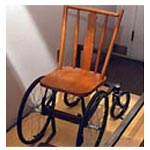 |
| Think about what has happened technologically since the 18th century. Man had invented the automobile, the airplane and even spacecraft. But the wheelchair is still in the same category with the horse drawn buggy and the sailing ship. Even our electric wheelchairs are still difficult to maneuver, difficult to get into small spaces, difficult to position to open doors, and difficult to transport from place to place. Millions of people could benefit from a substantial improvement to wheelchair technology. |
|
|
|
|
Innovative Wheelchairs Today
|
|
|
|
|
|
|
|
| The Ibot is a revolutionary wheelchair design. It is the Ferrari of all wheelchairs. It can do many things that regular wheelchairs cannot, like climb stairs, ride up over curbs, raise the rider up to reach the top part of a shelf. It can also travel through gravel and sand. The Food and Drug Administration had to reviews the wheelchair to get it on the market. FDA Commissioner Mark McClellan said, "It can help improve the quality of life of many people who use wheelchairs by enabling them to mange stairs, reach high shelves and hold eye-level conversations." It took 150 million U.S. dollars and eight years to make the Ibot. The Ibot is gryro-balanced so it can stand on either four wheels or two. To elevate the rider two of the wheels rotate on top of the other two. When on the two wheels the chair remains stable and the seat stays level. On all four wheels the Ibot can travel over rough terrain like gravel, sand or dirt. It can also go over curbs up to 4 inches high. The one major draw back it the cost, $29,000.00. Probably out of most people's range and maybe even out of insurance range. The design is quite innovative and may lead to new technologies and new designs for the future. One person who is getting an Ibot had this to say, "All I can tell you is WOW WOW WOW... what a machine, I ordered mine today. . . The best part is that it will fit right into the back of either of our Mini Van or our PT Cruiser, it will NOT require me to have a Custom made Van conversion, with some huge ramp and feeling even more disabled than I already am. . . It is VERY expensive, but worth every penny that is for sure. . . . ." Very interesting comment of not feeling more disabled than they were. |
|
|
|
|
|
|
|
|
|
|
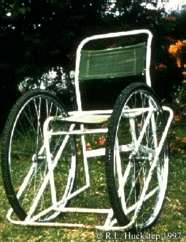
Huckstep Wheelchair
|
Wheelchairs for the Rest of the World
When you design a wheelchair for people who live in the United States, you can count on many environmental factors. Most places have sidewalks, paved streets, and even many places with wheelchair access ramps. There is no lack of available materials to build from. Also, many people have insurance or state or government aide to help with the cost. But what about other countries? Many 3rd world countries don't have sidewalks, paved streets and certainly not many places with wheelchair access. There are many other considerations for a useful wheelchair. Any design has to be cheap to make and needs to be made from materials easily obtained from the local area. A simple design would let local semi-skilled labor manufacture it. It also has to be tough enough to withstand the conditions, low enough to the ground to get in and out of, and high enough to clear pot holes and small drains.
|
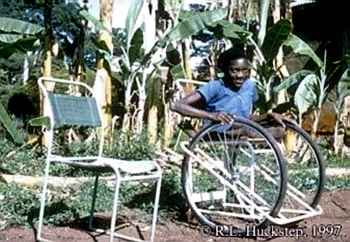
Ugandan using the Huckstep Wheelchair, 1997
|
Dr. Ronald Huckstep, an English born physician, While working in Uganda in 1967 doing poliomyelitis research, an English born physician, Dr. Ronald Huckstep, designed a tubular wheelchair. He used old bicycle parts and chair frames, two bicycle wheels and a third castor wheel from an old hospital cart. Canvas mail bags were used to make the seats. These kinds of parts could be easily found in most communities. One thousand of these chairs had been built by 1975. They cost only $50 to $100 to make. The Huckstep chair has many advantages: the long wheel base lets it go up and down curbs; the three wheels give good traction with the large wheels always on the ground; the cost is low and it is easy to make; it uses off the shelf pieces or used pieces; and non-skilled workers can learn to make it. There are disadvantages in the design though: it's hard to get in and out of because of the large wheels in the front; it's hard to get close to a table; the wheels slip in the sand; and it's hard to push with the wheels in the front.
|
|
|
|
| The Huckstep wheelchair was revolutionary for wheelchair design in 3rd world countries. It has helped disabled persons in Uganda to fight for disability rights. Uganda now is a leader in the disability right movement in Africa. |
|
|
|
|
|
|
|
|
|
|
|
|
|
|
|
|


